Six months after showing maniac episodes, Leroy lost his job
VerifiedAdded on 2022/10/17
|6
|1816
|119
AI Summary
| ||In the whole seven-minute video, Leroy has not made a single| ||eye contact properly with the psychiatrist and also did not | ||keep a proper sitting posture.| ||In the entire seven-minute video, Leroy is seen to rub his | |Speech|face with his palm before conversing, and also he is | ||stammering while speaking.
Contribute Materials
Your contribution can guide someone’s learning journey. Share your
documents today.
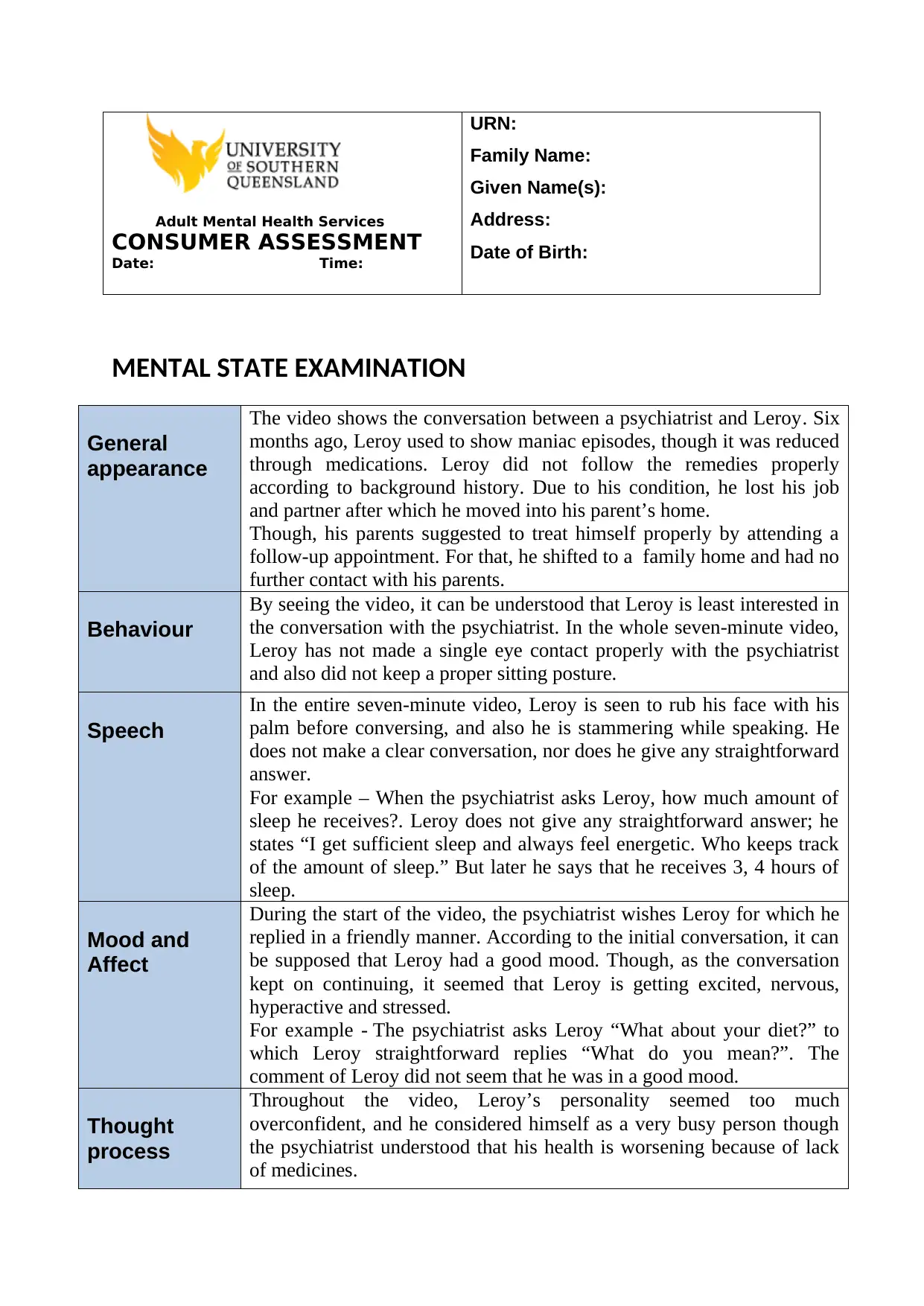
Adult Mental Health Services
CONSUMER ASSESSMENT
Date: Time:
URN:
Family Name:
Given Name(s):
Address:
Date of Birth:
MENTAL STATE EXAMINATION
General
appearance
The video shows the conversation between a psychiatrist and Leroy. Six
months ago, Leroy used to show maniac episodes, though it was reduced
through medications. Leroy did not follow the remedies properly
according to background history. Due to his condition, he lost his job
and partner after which he moved into his parent’s home.
Though, his parents suggested to treat himself properly by attending a
follow-up appointment. For that, he shifted to a family home and had no
further contact with his parents.
Behaviour
By seeing the video, it can be understood that Leroy is least interested in
the conversation with the psychiatrist. In the whole seven-minute video,
Leroy has not made a single eye contact properly with the psychiatrist
and also did not keep a proper sitting posture.
Speech
In the entire seven-minute video, Leroy is seen to rub his face with his
palm before conversing, and also he is stammering while speaking. He
does not make a clear conversation, nor does he give any straightforward
answer.
For example – When the psychiatrist asks Leroy, how much amount of
sleep he receives?. Leroy does not give any straightforward answer; he
states “I get sufficient sleep and always feel energetic. Who keeps track
of the amount of sleep.” But later he says that he receives 3, 4 hours of
sleep.
Mood and
Affect
During the start of the video, the psychiatrist wishes Leroy for which he
replied in a friendly manner. According to the initial conversation, it can
be supposed that Leroy had a good mood. Though, as the conversation
kept on continuing, it seemed that Leroy is getting excited, nervous,
hyperactive and stressed.
For example - The psychiatrist asks Leroy “What about your diet?” to
which Leroy straightforward replies “What do you mean?”. The
comment of Leroy did not seem that he was in a good mood.
Thought
process
Throughout the video, Leroy’s personality seemed too much
overconfident, and he considered himself as a very busy person though
the psychiatrist understood that his health is worsening because of lack
of medicines.
CONSUMER ASSESSMENT
Date: Time:
URN:
Family Name:
Given Name(s):
Address:
Date of Birth:
MENTAL STATE EXAMINATION
General
appearance
The video shows the conversation between a psychiatrist and Leroy. Six
months ago, Leroy used to show maniac episodes, though it was reduced
through medications. Leroy did not follow the remedies properly
according to background history. Due to his condition, he lost his job
and partner after which he moved into his parent’s home.
Though, his parents suggested to treat himself properly by attending a
follow-up appointment. For that, he shifted to a family home and had no
further contact with his parents.
Behaviour
By seeing the video, it can be understood that Leroy is least interested in
the conversation with the psychiatrist. In the whole seven-minute video,
Leroy has not made a single eye contact properly with the psychiatrist
and also did not keep a proper sitting posture.
Speech
In the entire seven-minute video, Leroy is seen to rub his face with his
palm before conversing, and also he is stammering while speaking. He
does not make a clear conversation, nor does he give any straightforward
answer.
For example – When the psychiatrist asks Leroy, how much amount of
sleep he receives?. Leroy does not give any straightforward answer; he
states “I get sufficient sleep and always feel energetic. Who keeps track
of the amount of sleep.” But later he says that he receives 3, 4 hours of
sleep.
Mood and
Affect
During the start of the video, the psychiatrist wishes Leroy for which he
replied in a friendly manner. According to the initial conversation, it can
be supposed that Leroy had a good mood. Though, as the conversation
kept on continuing, it seemed that Leroy is getting excited, nervous,
hyperactive and stressed.
For example - The psychiatrist asks Leroy “What about your diet?” to
which Leroy straightforward replies “What do you mean?”. The
comment of Leroy did not seem that he was in a good mood.
Thought
process
Throughout the video, Leroy’s personality seemed too much
overconfident, and he considered himself as a very busy person though
the psychiatrist understood that his health is worsening because of lack
of medicines.
Secure Best Marks with AI Grader
Need help grading? Try our AI Grader for instant feedback on your assignments.
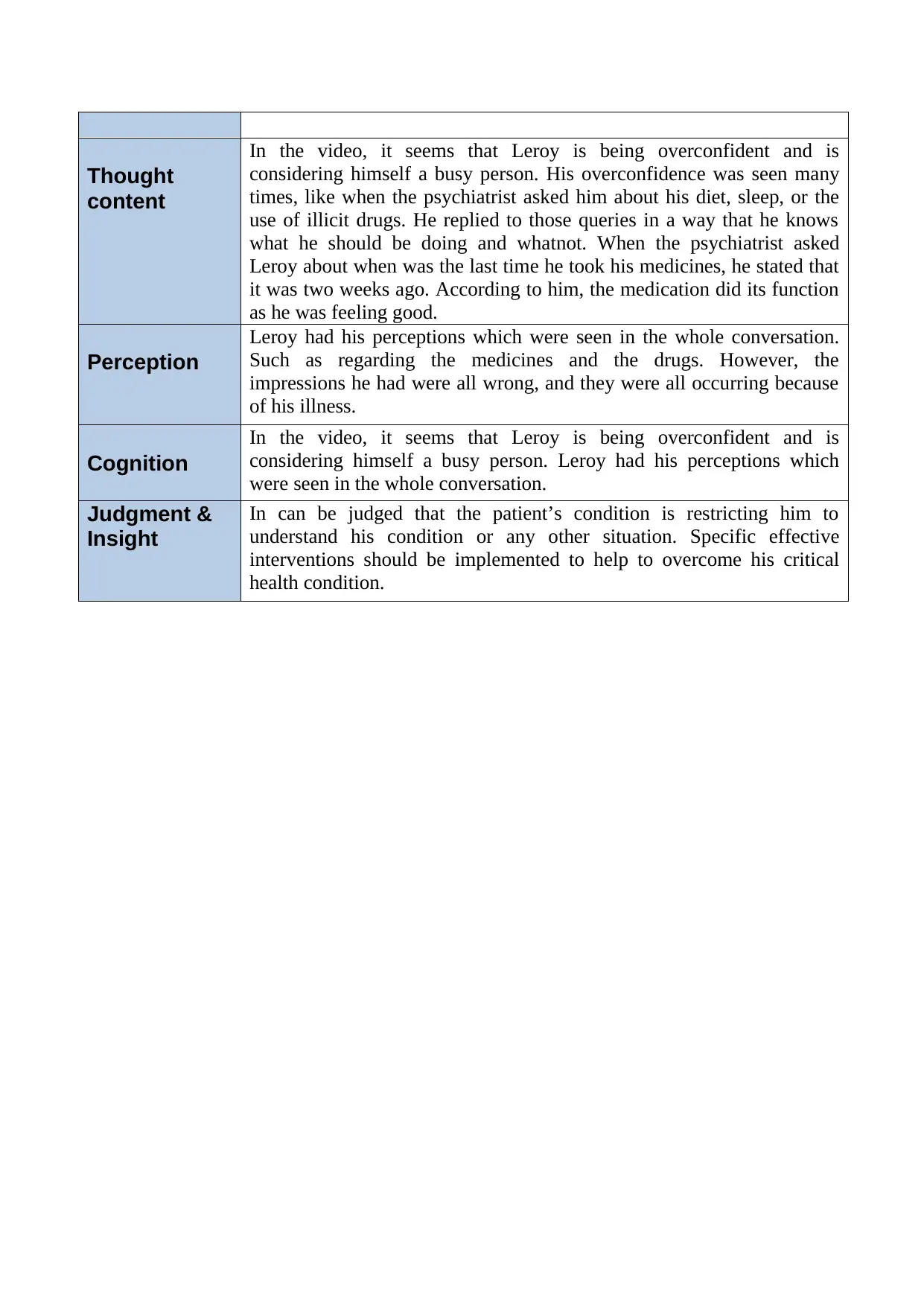
Thought
content
In the video, it seems that Leroy is being overconfident and is
considering himself a busy person. His overconfidence was seen many
times, like when the psychiatrist asked him about his diet, sleep, or the
use of illicit drugs. He replied to those queries in a way that he knows
what he should be doing and whatnot. When the psychiatrist asked
Leroy about when was the last time he took his medicines, he stated that
it was two weeks ago. According to him, the medication did its function
as he was feeling good.
Perception
Leroy had his perceptions which were seen in the whole conversation.
Such as regarding the medicines and the drugs. However, the
impressions he had were all wrong, and they were all occurring because
of his illness.
Cognition
In the video, it seems that Leroy is being overconfident and is
considering himself a busy person. Leroy had his perceptions which
were seen in the whole conversation.
Judgment &
Insight
In can be judged that the patient’s condition is restricting him to
understand his condition or any other situation. Specific effective
interventions should be implemented to help to overcome his critical
health condition.
content
In the video, it seems that Leroy is being overconfident and is
considering himself a busy person. His overconfidence was seen many
times, like when the psychiatrist asked him about his diet, sleep, or the
use of illicit drugs. He replied to those queries in a way that he knows
what he should be doing and whatnot. When the psychiatrist asked
Leroy about when was the last time he took his medicines, he stated that
it was two weeks ago. According to him, the medication did its function
as he was feeling good.
Perception
Leroy had his perceptions which were seen in the whole conversation.
Such as regarding the medicines and the drugs. However, the
impressions he had were all wrong, and they were all occurring because
of his illness.
Cognition
In the video, it seems that Leroy is being overconfident and is
considering himself a busy person. Leroy had his perceptions which
were seen in the whole conversation.
Judgment &
Insight
In can be judged that the patient’s condition is restricting him to
understand his condition or any other situation. Specific effective
interventions should be implemented to help to overcome his critical
health condition.
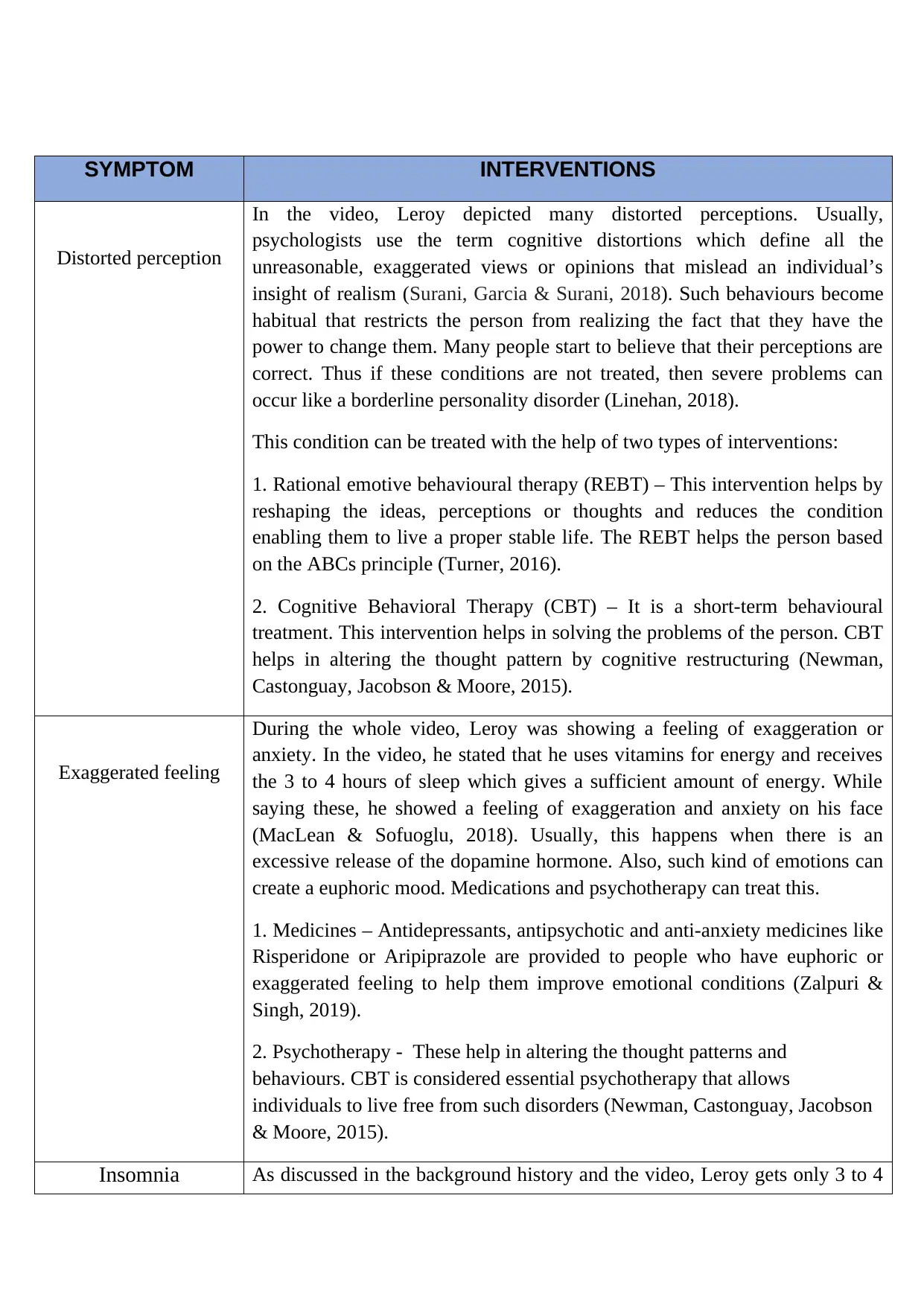
SYMPTOM INTERVENTIONS
Distorted perception
In the video, Leroy depicted many distorted perceptions. Usually,
psychologists use the term cognitive distortions which define all the
unreasonable, exaggerated views or opinions that mislead an individual’s
insight of realism (Surani, Garcia & Surani, 2018). Such behaviours become
habitual that restricts the person from realizing the fact that they have the
power to change them. Many people start to believe that their perceptions are
correct. Thus if these conditions are not treated, then severe problems can
occur like a borderline personality disorder (Linehan, 2018).
This condition can be treated with the help of two types of interventions:
1. Rational emotive behavioural therapy (REBT) – This intervention helps by
reshaping the ideas, perceptions or thoughts and reduces the condition
enabling them to live a proper stable life. The REBT helps the person based
on the ABCs principle (Turner, 2016).
2. Cognitive Behavioral Therapy (CBT) – It is a short-term behavioural
treatment. This intervention helps in solving the problems of the person. CBT
helps in altering the thought pattern by cognitive restructuring (Newman,
Castonguay, Jacobson & Moore, 2015).
Exaggerated feeling
During the whole video, Leroy was showing a feeling of exaggeration or
anxiety. In the video, he stated that he uses vitamins for energy and receives
the 3 to 4 hours of sleep which gives a sufficient amount of energy. While
saying these, he showed a feeling of exaggeration and anxiety on his face
(MacLean & Sofuoglu, 2018). Usually, this happens when there is an
excessive release of the dopamine hormone. Also, such kind of emotions can
create a euphoric mood. Medications and psychotherapy can treat this.
1. Medicines – Antidepressants, antipsychotic and anti-anxiety medicines like
Risperidone or Aripiprazole are provided to people who have euphoric or
exaggerated feeling to help them improve emotional conditions (Zalpuri &
Singh, 2019).
2. Psychotherapy - These help in altering the thought patterns and
behaviours. CBT is considered essential psychotherapy that allows
individuals to live free from such disorders (Newman, Castonguay, Jacobson
& Moore, 2015).
Insomnia As discussed in the background history and the video, Leroy gets only 3 to 4
Distorted perception
In the video, Leroy depicted many distorted perceptions. Usually,
psychologists use the term cognitive distortions which define all the
unreasonable, exaggerated views or opinions that mislead an individual’s
insight of realism (Surani, Garcia & Surani, 2018). Such behaviours become
habitual that restricts the person from realizing the fact that they have the
power to change them. Many people start to believe that their perceptions are
correct. Thus if these conditions are not treated, then severe problems can
occur like a borderline personality disorder (Linehan, 2018).
This condition can be treated with the help of two types of interventions:
1. Rational emotive behavioural therapy (REBT) – This intervention helps by
reshaping the ideas, perceptions or thoughts and reduces the condition
enabling them to live a proper stable life. The REBT helps the person based
on the ABCs principle (Turner, 2016).
2. Cognitive Behavioral Therapy (CBT) – It is a short-term behavioural
treatment. This intervention helps in solving the problems of the person. CBT
helps in altering the thought pattern by cognitive restructuring (Newman,
Castonguay, Jacobson & Moore, 2015).
Exaggerated feeling
During the whole video, Leroy was showing a feeling of exaggeration or
anxiety. In the video, he stated that he uses vitamins for energy and receives
the 3 to 4 hours of sleep which gives a sufficient amount of energy. While
saying these, he showed a feeling of exaggeration and anxiety on his face
(MacLean & Sofuoglu, 2018). Usually, this happens when there is an
excessive release of the dopamine hormone. Also, such kind of emotions can
create a euphoric mood. Medications and psychotherapy can treat this.
1. Medicines – Antidepressants, antipsychotic and anti-anxiety medicines like
Risperidone or Aripiprazole are provided to people who have euphoric or
exaggerated feeling to help them improve emotional conditions (Zalpuri &
Singh, 2019).
2. Psychotherapy - These help in altering the thought patterns and
behaviours. CBT is considered essential psychotherapy that allows
individuals to live free from such disorders (Newman, Castonguay, Jacobson
& Moore, 2015).
Insomnia As discussed in the background history and the video, Leroy gets only 3 to 4
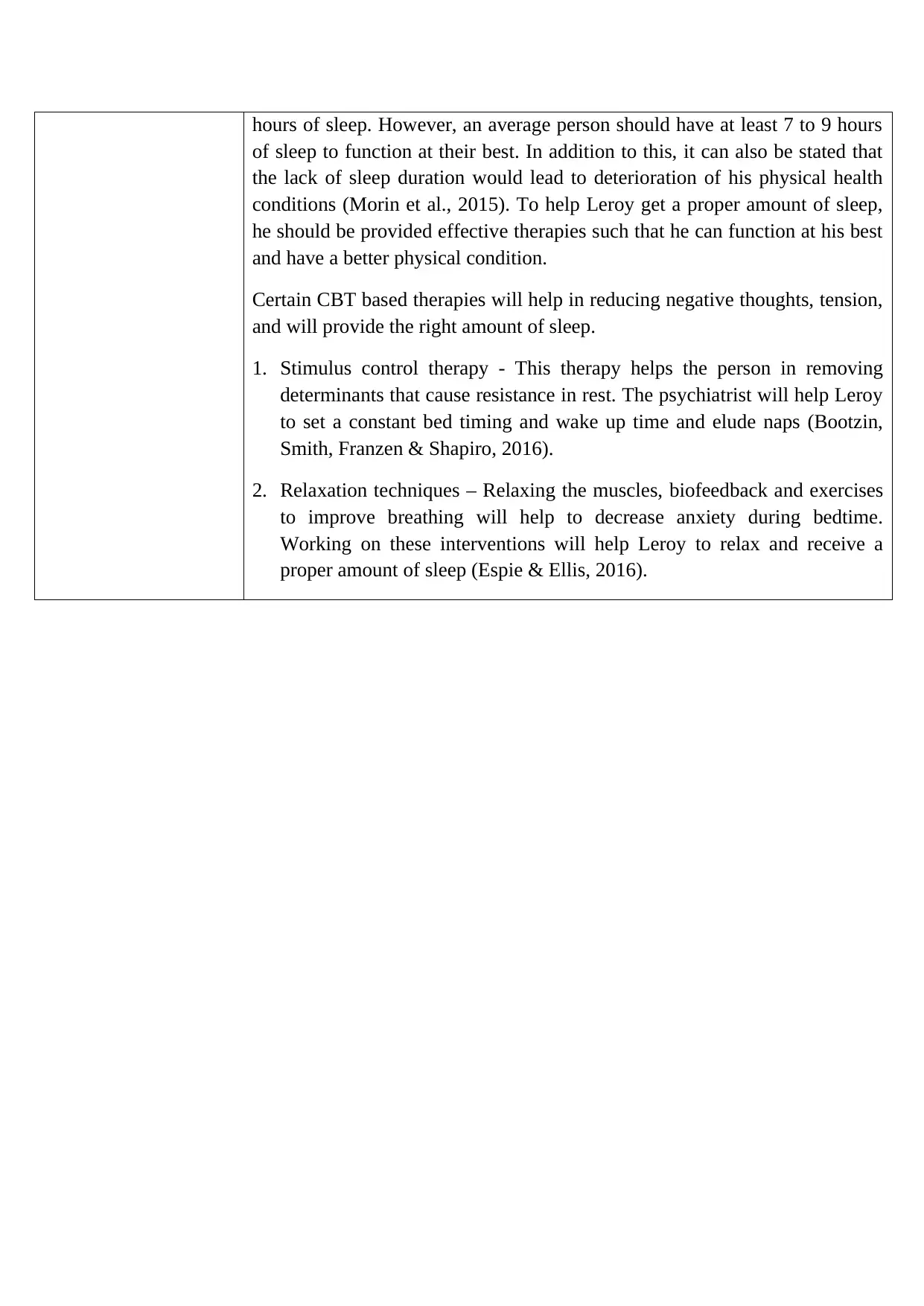
hours of sleep. However, an average person should have at least 7 to 9 hours
of sleep to function at their best. In addition to this, it can also be stated that
the lack of sleep duration would lead to deterioration of his physical health
conditions (Morin et al., 2015). To help Leroy get a proper amount of sleep,
he should be provided effective therapies such that he can function at his best
and have a better physical condition.
Certain CBT based therapies will help in reducing negative thoughts, tension,
and will provide the right amount of sleep.
1. Stimulus control therapy - This therapy helps the person in removing
determinants that cause resistance in rest. The psychiatrist will help Leroy
to set a constant bed timing and wake up time and elude naps (Bootzin,
Smith, Franzen & Shapiro, 2016).
2. Relaxation techniques – Relaxing the muscles, biofeedback and exercises
to improve breathing will help to decrease anxiety during bedtime.
Working on these interventions will help Leroy to relax and receive a
proper amount of sleep (Espie & Ellis, 2016).
of sleep to function at their best. In addition to this, it can also be stated that
the lack of sleep duration would lead to deterioration of his physical health
conditions (Morin et al., 2015). To help Leroy get a proper amount of sleep,
he should be provided effective therapies such that he can function at his best
and have a better physical condition.
Certain CBT based therapies will help in reducing negative thoughts, tension,
and will provide the right amount of sleep.
1. Stimulus control therapy - This therapy helps the person in removing
determinants that cause resistance in rest. The psychiatrist will help Leroy
to set a constant bed timing and wake up time and elude naps (Bootzin,
Smith, Franzen & Shapiro, 2016).
2. Relaxation techniques – Relaxing the muscles, biofeedback and exercises
to improve breathing will help to decrease anxiety during bedtime.
Working on these interventions will help Leroy to relax and receive a
proper amount of sleep (Espie & Ellis, 2016).
Secure Best Marks with AI Grader
Need help grading? Try our AI Grader for instant feedback on your assignments.
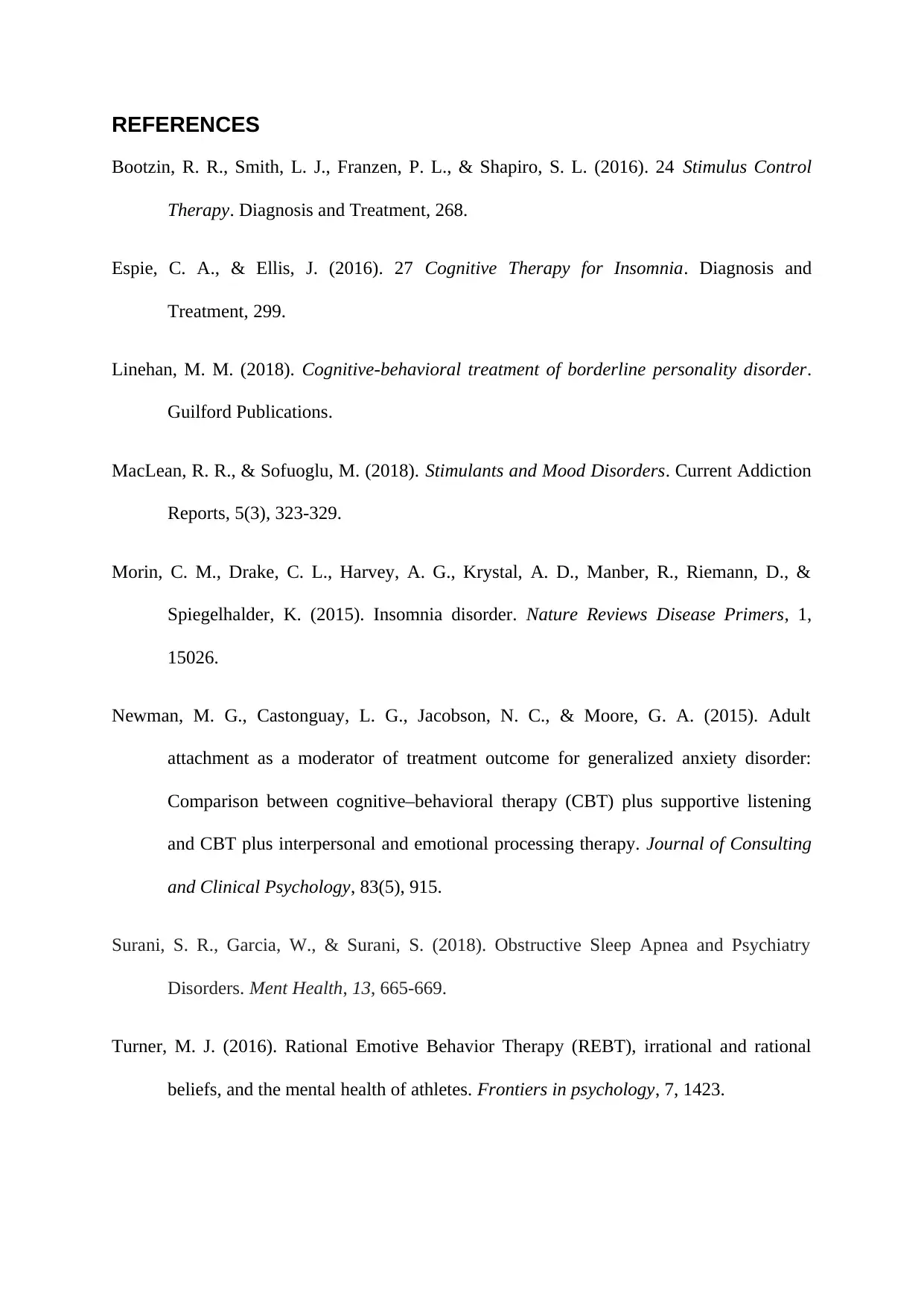
REFERENCES
Bootzin, R. R., Smith, L. J., Franzen, P. L., & Shapiro, S. L. (2016). 24 Stimulus Control
Therapy. Diagnosis and Treatment, 268.
Espie, C. A., & Ellis, J. (2016). 27 Cognitive Therapy for Insomnia. Diagnosis and
Treatment, 299.
Linehan, M. M. (2018). Cognitive-behavioral treatment of borderline personality disorder.
Guilford Publications.
MacLean, R. R., & Sofuoglu, M. (2018). Stimulants and Mood Disorders. Current Addiction
Reports, 5(3), 323-329.
Morin, C. M., Drake, C. L., Harvey, A. G., Krystal, A. D., Manber, R., Riemann, D., &
Spiegelhalder, K. (2015). Insomnia disorder. Nature Reviews Disease Primers, 1,
15026.
Newman, M. G., Castonguay, L. G., Jacobson, N. C., & Moore, G. A. (2015). Adult
attachment as a moderator of treatment outcome for generalized anxiety disorder:
Comparison between cognitive–behavioral therapy (CBT) plus supportive listening
and CBT plus interpersonal and emotional processing therapy. Journal of Consulting
and Clinical Psychology, 83(5), 915.
Surani, S. R., Garcia, W., & Surani, S. (2018). Obstructive Sleep Apnea and Psychiatry
Disorders. Ment Health, 13, 665-669.
Turner, M. J. (2016). Rational Emotive Behavior Therapy (REBT), irrational and rational
beliefs, and the mental health of athletes. Frontiers in psychology, 7, 1423.
Bootzin, R. R., Smith, L. J., Franzen, P. L., & Shapiro, S. L. (2016). 24 Stimulus Control
Therapy. Diagnosis and Treatment, 268.
Espie, C. A., & Ellis, J. (2016). 27 Cognitive Therapy for Insomnia. Diagnosis and
Treatment, 299.
Linehan, M. M. (2018). Cognitive-behavioral treatment of borderline personality disorder.
Guilford Publications.
MacLean, R. R., & Sofuoglu, M. (2018). Stimulants and Mood Disorders. Current Addiction
Reports, 5(3), 323-329.
Morin, C. M., Drake, C. L., Harvey, A. G., Krystal, A. D., Manber, R., Riemann, D., &
Spiegelhalder, K. (2015). Insomnia disorder. Nature Reviews Disease Primers, 1,
15026.
Newman, M. G., Castonguay, L. G., Jacobson, N. C., & Moore, G. A. (2015). Adult
attachment as a moderator of treatment outcome for generalized anxiety disorder:
Comparison between cognitive–behavioral therapy (CBT) plus supportive listening
and CBT plus interpersonal and emotional processing therapy. Journal of Consulting
and Clinical Psychology, 83(5), 915.
Surani, S. R., Garcia, W., & Surani, S. (2018). Obstructive Sleep Apnea and Psychiatry
Disorders. Ment Health, 13, 665-669.
Turner, M. J. (2016). Rational Emotive Behavior Therapy (REBT), irrational and rational
beliefs, and the mental health of athletes. Frontiers in psychology, 7, 1423.

Zalpuri, I., & Singh, M. K. (2019). Principles of Treatment of Mood Disorders Across
Development. Clinical Handbook for the Diagnosis and Treatment of Pediatric Mood
Disorders, 83.
Development. Clinical Handbook for the Diagnosis and Treatment of Pediatric Mood
Disorders, 83.
1 out of 6
Related Documents
Your All-in-One AI-Powered Toolkit for Academic Success.
+13062052269
info@desklib.com
Available 24*7 on WhatsApp / Email
![[object Object]](/_next/static/media/star-bottom.7253800d.svg)
Unlock your academic potential
© 2024 | Zucol Services PVT LTD | All rights reserved.

![[pic]. |URN:8675309. | |. |Family Name: Smith. | |Adult](/_next/image/?url=https%3A%2F%2Fdesklib.com%2Fmedia%2Fimages%2Fxh%2F02b954cc1fa344b1a336248d483c0f00.jpg&w=256&q=75)



